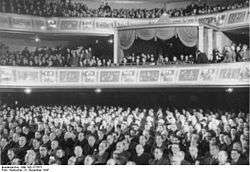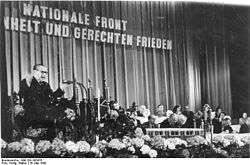German People's Congress
The German People's Congress (German: Deutscher Volkskongress) was an initiative of the SED and the participation of the bloc parties at the London Conference of Allied Foreign Ministers in November and December 1947. Delegates from all over Germany gathered for the first time on 6 December 1947 that entered together body. Their main demand was the key to a German government.[1] The SED presented their all-German claim to the three people's congresses.
Historical background
After the Second World War, the cooperation of the four victorious powers was soon superseded by the East-West confrontation. The growing East-West conflict between the USSR and the Western powers, such as the Middle East and Asia, as well as Soviet policy, satellite states to build (the so-called Eastern Bloc), led to distrust of Western powers in relation to the Soviet policy in Germany. U.S. demands in the Allied Control Council, to preserve the economic unity of Germany, were dismissed in July 1946 by the USSR as an attempt to influence. The four-power administration over Germany ended no later than the last meeting of the Supervisory Council on 20 March 1948.
The London 6-Power Conference was set in the first half of 1948 principles for the establishment of a democratic German state (the Frankfurt documents). While in the three western zones of the reconstruction of democracy was, went in the Soviet zone of occupation, the increasing uniformity of the semi-free elections in the Soviet zone in 1946 elected democratic institutions vonstatten. Since not freely elected governments in the Soviet countries were reached, the Prime Minister summarized in the west of Koblenz decisions, according to which democratic West German state as a temporary part to the restoration of German unity should be established in the wild.
People's Congress movement
The People's Congress movement was at the initiative of the Socialist Unity Party 26 November founded in 1947 and served as its first political forum for Germany to incorporate elements of direct democracy and civic groups in a representative government. They also used the SED to the involvement of political parties, mass organizations, cultural associations and individuals to achieve their political goals and was directed against the American and British policy and the Marshall Plan. Emerged from the movement of the German people's congresses, the first on 6/7 December 1947 of "delegates" of all occupation zones was composed. Prohibited under review and resistances against these SED initiative on the part of the Christian Democratic Union, and the removal of its chairman Jakob Kaiser and Ernst Lemmer through SMAD Western occupying powers to mobilize the People's Congresses in "Trizonia".
First Congress

The First German People's Congress for Unity and a Just Peace went back to the initiative of the SED. It let delegates from political parties and mass organizations to determine who came predominantly from the Soviet zone of occupation. Only a small proportion came from the western zones. These representatives came on 6 and 7 December 1947 in Berlin together. Participation in the People's Congress, was among the parties in the Soviet zone of much discussion. The refusal of the CDU to participate was one of the reasons that led to the dismissal of Jacob Kaiser as CDU chairman by the SMAD. Under strong pressure from the occupying power against the will of the majority of national associations, the Liberal Democratic Party decided to participate. The crucial point of criticism was that the Congress should not be composed according to the election results. By including the mass organizations had a higher distribution of members of the SED, which were usually also members of mass organizations, possible from the outset.
According to estimates by Erich Gniffke was due to the political affiliation of most members of mass organizations to the SED 62% of the participant member of the SED, and another 10% member of the Communist Party. Although these estimates are at odds with the official figures (see table) are available, it is clear that the SED had a clear majority in the People's Congress. Topics included the rejection of the planned construction of a West German state and the criticism of the US-British occupation policy. They discussed the preparation of a peace treaty and an all-German government "composed of representatives of all democratic parties". Here, the Congress rejected much of the Soviet policy on Germany and supported this. This is the reason why this motion was approved by the Soviet Military Administration and supported by the SED. To represent the Congress appointed a 17-member delegation to the London Conference of Foreign Ministers (November–December 1947) the positions of the Congress. The foreign minister saw no legitimacy of the delegation and did not receive it.
Second congress
The Second German People's Congress held on 17-18. March 1948. The appointment was with 18 March at the 100th Anniversary of the revolution 1848/1849 set. At the People's Congress was attended by 1898 delegates, including 512 from the western zones.[2] It rejected of the Marshall Plan, the recognition of the Oder-Neisse line, and a petition was agreed to German reunification, 23 May to 13 June 1948 took place. He was the newspaper of "German voice" out.
Furthermore, the First German People's Council was elected, which included 400 members, of which 100 were from West Germany. It was formed a constitutional committee, which was led by Otto Grotewohl and should draw up a draft constitution for the future German Democratic Republic.
Third congress

The Third German People's Congress on the population of the Soviet occupation zone 15 and 16 May 1949 by one vote confirms'. The 'choice' for the People's Congress was to assent (Yes) or reject (No), the following statement:
"I am in favor of German unity and a just peace agreement. I agree about the following list of candidates for the Third German People's Congress."
More than four million of the approximately 13.5 million eligible voters have ticked no. On the approval (officially about 66% of votes) are still reasonable doubt, as about a million unfilled ballots were counted as agreement.[3]
On 29–30 May 1949 the German People's Congress convened in Berlin. 1400 delegates came from the Soviet occupation zone, 610 from the western zones (Trizone) located on 23 May was constituted as a federal republic. The draft Constitution, the Constitutional Committee of the People's Council had been drawn up on 30 May approved with one vote against, selected [5] and the Second German People's Council. The People's Council was constituted under the influence of the founding of the Federal Republic of Germany (May 23, 1949) on the same day as the Provisional People's Chamber on 7 October 1949 newly founded German Democratic Republic.
See also
- German Economic Commission
- German People's Council
- People's Control Commission
- Merger of the KPD and SPD into the Socialist Unity Party of Germany
References
- Lexikom A–Z in zwei Bänden, Erster Band, Volkseigener Verlag Enzyklopädie, Leipzig 1956, S. 375.
- Institut für Marxismus-Leninismus beim Zentralkomitee der SED: Geschichte der deutschen Arbeiterbewegung, Band 6, Von 1945 bis 1949. Autorenkollektiv: Walter Ulbricht u. A., Dietz Verlag, Berlin 1966, S. 240.
- Siegfried Suckut, Parteien in der SBZ/DDR 1945–1952. Bundeszentrale für Politische Bildung, Bonn 2000, ISBN 3-89331-384-2, S. 73.